This chapter discusses network management standards, models, and language. It covers the OSI, SNMP, and TMN standards and their organization, information, functional, and communication models. The chapter also describes management information bases (MIBs) and their structure, objects, and views. Finally, it discusses ASN.1 as the language used to define management information and objects.

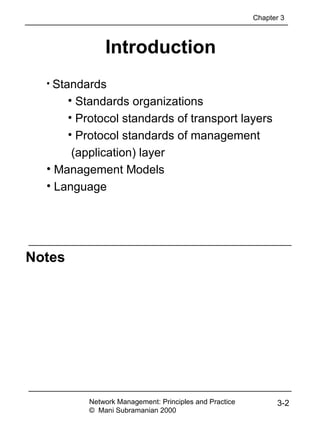





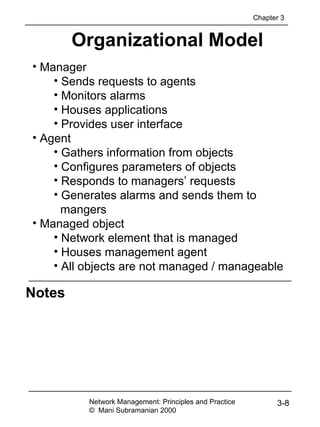




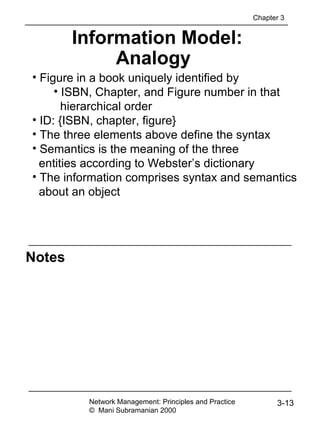


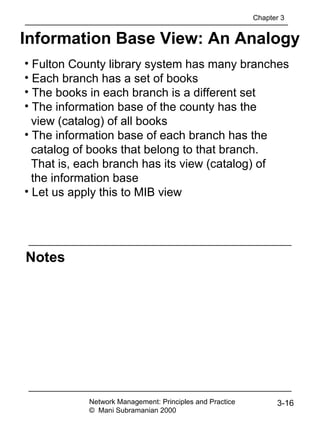
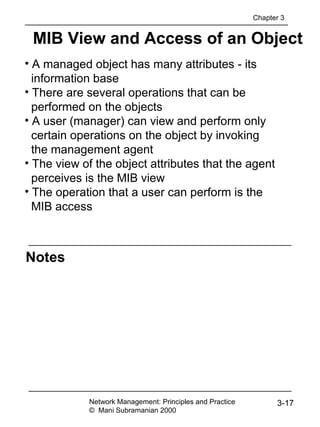











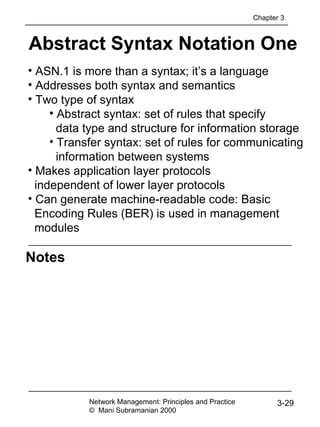



![Notes
Data Type: Example 1
Network Management: Principles and Practice
© Mani Subramanian 2000
3-33
• Module name starts with capital letters
• Data types:
• Primitives: NULL, GraphicString
• Constructs
• Alternatives : CHOICE
• List maker: SET, SEQUENCE
• Repetition: SET OF, SEQUENCE OF:
• Difference between SET and SEQUENCE
PersonnelRecord ::= SET
{ Name,
title GraphicString,
division CHOICE
marketing [0] SEQUENCE
{Sector,
Country},
research [1] CHOICE
{product-based [0] NULL,
basic [1] NULL},
production [2] SEQUENCE
{Product-line,
Country } }
etc.
Figure 3.13 ASN.1 Data Type Definition Example 1
Chapter 3](https://image.slidesharecdn.com/nwmch3-150119214853-conversion-gate01/85/Network-Management-33-320.jpg)

![Notes
ASN.1 Symbols
Symbol Meaning
::= Defined as
| or, alternative, options of a list
- Signed number
-- Following the symbol are comments
{} Start and end of a list
[] Start and end of a tag
() Start and end of subtype
.. Range
Network Management: Principles and Practice
© Mani Subramanian 2000
3-35
Chapter 3](https://image.slidesharecdn.com/nwmch3-150119214853-conversion-gate01/85/Network-Management-35-320.jpg)




![Notes
Tag
Network Management: Principles and Practice
© Mani Subramanian 2000
3-40
• Tag uniquely identifies a data type
• Comprises class and tag number
• Class:
• Universal - always true
• Application - only in the application used
• Context-specific - specific context in application
• Private - used extensively by commercial
vendors
Example:
BOOLEAN Universal 1
INTEGER Universal 2
research Application [1] (Figure 3.13)
product-based Context-specific under research [0]
Chapter 3](https://image.slidesharecdn.com/nwmch3-150119214853-conversion-gate01/85/Network-Management-40-320.jpg)


![Name: John P Smith
Title: Director
Employee Number 51
Date of Hire: 17 September 1971
Name of Spouse; Mary T Smith
Number of Children 2
Child Information
Name Ralph T Smith
Date of Birth 11 November 1957
Child Information
Name Susan B Jones
Date of Birth 17 July 1959
(a) Informal description of personnel record
---------------------------------------------------------------------------------------------------------
PersonnelRecord ::= [APPLICATION 0] IMPLICIT SET {
Name,
title [0] VisibleString,
number EmployeeNumber,
dateOfHire [1] Date,
nameOfSpouse [2] Name,
children [3] IMPLICIT SEQUENCE OF ChildInformation DEFAULT { } }
ChildInformation ::= SET {
Name,
dateOfBirth [0] Date }
Name ::= [APPLICATION 1] IMPLICIT SEQUENCE {
givenName VisibleString,
initial VisibleString,
familyName VisibleString }
EmployeeNumber ::= [APPLICATION 2] IMPLICIT INTEGER
Date ::= [APPLICATION 3] IMPLICIT VisibleString -- YYYYMMDD
(b) ASN.1 description of the record structure
---------------------------------------------------------------------------------------------------------
{ {givenName “John”, initial “T”, familyName “Smith”},
title “Director”
number “51”
dateOfHire “19710917”
nameOfSpouse {givenName “Mary”, initial “T”, familyName “Smith”},
children
{ { {givenName “Ralph”, initial “T”, familyName “Smith”},
dateOfBirth “19571111”},
{ {givenName “Susan”, initial “B”, familyName “Jones”}
dateOfBirth “19590717”}}}
(c) ASN.1 description of a record value
Network Management: Principles and Practice
© Mani Subramanian 2000
3-43](https://image.slidesharecdn.com/nwmch3-150119214853-conversion-gate01/85/Network-Management-43-320.jpg)



